VI.
PLANT COMMUNITIES
B. COASTAL SCRUB
Coastal
scrub communities occur in cismontane California -
west of the Sierra Nevada - and northwestern Baja
California on relatively shallow, dry soils (compared
to chaparral) in areas where a Mediterranean climate
prevails. They are found at elevations ranging from
near sea level to 1800 feet. A stand located in a
moister climate, such as under the influence of coastal
fogs, may reach six and a half, or more, feet tall.
However, one located in a drier climate, such as on
the interior slope of a hillside located in a rain
shadow, may reach only nine inches tall. Factors such
as latitude, proximity to the ocean, and substrate
all exercise their influence on the distribution,
species composition, and physiognomy of coastal scrub
communities.
Various
names have been used to refer to the coastal scrub.
"Coastal sage scrub" has been used because of the
predominance of California sagebrush (Artemisia
californica) and black sage (Salvia mellifera)
in many associations of this community. In southern
California, coastal scrub is often called "soft chaparral"
(vs. "hard chaparral" or chaparral). Some authors
recognize two distinct plant formations based on species
composition: "coastal sage scrub" (with four geographically
distinct floristic associations found within coastal
California between San Francisco Bay and El Rosario,
Baja California) and "coastal succulent scrub" (found
in coastal Baja California). According to this classification,
the coastal scrub populations of Poly Canyon are located
within the Diablan floristic association of the coastal
sage scrub plant formation. Other authors describe
three vegetational types of coastal scrub: "coastal
sage scrub" occurring mainly along the coast from
Pt. Sur, Monterey County to Baja California, "coastal
sage succulent scrub" from south of San Diego to El
Rosario, and "northern coastal scrub," a narrow coastal
strip extending from Pt. Sur to Oregon. Based on this
classification, Poly Canyon is found in the coastal
sage scrub. "Coastal yucca scrub" is a specialized
type of coastal scrub, dominated by Yucca whipplei,
found on coarse, rocky, infertile (often serpentinitic)
soils.
Dominant
species of coastal scrub are often suffrutescent and,
compared to those found in chaparral, relatively soft-stemmed.
Herbage can be glutinous, resinous, and pungently
scented with volatile oils, as in coyote bush (Baccharis
pilularis) and sticky monkeyflower (Mimulus
aurantiacus). However, most species are drought
avoiders with malacophyllous (soft, thin), often summer-deciduous
leaves, such as black sage (Salvia mellifera)
and deerweed (Lotus scoparius). Western poison
oak (Toxicodendron diversilobum) is a winter-deciduous
exception. Other species such as sticky monkeyflower
(Mimulus aurantiacus) are adapted to summer
drought by having stems whose terminal portions die
back during excessively dry periods. A few coastal
scrub species are sclerophyllous: one is California
buckwheat (Eriogonum fasciculatum). Some are
evergreen: coyote brush (Baccharis pilularis)
and California coffeeberry (Rhamnus californica).
Roots are relatively shallow (typically half as deep
as those of chaparral species), though this may be
due more to soil depth than physiological requirements.
Most active growth starts early, immediately following
the rainy season in November and December and continues
into the spring. There is a fairly large herbaceous
component to coastal scrub (relative to chaparral).
Fire
is an important element in the ecology of coastal
scrub. The predominant species have crowns whose vegetative
buds resprout after fires, just as in many chaparral
species. The rapid regrowth by root crown sprouting
and small wind-dispersed seeds often make these species
successional to chaparral after fire or other disturbance.
When fire occurs too frequently, coastal scrub may
be replaced by grasslands that are often dominated
by non-native annual species.
Relative
to chaparral, few studies have been done on the coastal
scrub communities. Given the rapid destruction of
this vegetation type, mainly through urban and agricultural
development, more energy should be dedicated to understanding
coastal scrub ecology.
In
Poly Canyon, coastal scrub tends to occupy the more
xeric or dry sites, forming a dense cover over the
infertile, rocky serpentinitic hillsides. One of the
most common species in our coastal scrub is black
sage (Salvia mellifera). Monotypic stands of
black sage cover a couple of these hills, where it
may be successional to chaparral in disturbed, often
burned, areas. The soils beneath such communities
are typically bright red, revealing their volcanic
origins. A form of coastal scrub which is quite conspicuous
on the steeper, rockier slopes of Poly Canyon is yucca
scrub, dominated by yucca (Yucca whipplei).
Near the mouth of the Canyon, the coastal scrub communities
are composed of different species - especially California
sagebrush (Artemisia californica) and coyote
brush (Baccharis pilularis). Here, the coastal
scrub is denser, taller, and, in several places, intergrades
with coastal live oak woodland.
- Dominant
plants of the coastal scrub in Poly Canyon are:
- *California
sagebrush, coastal sagebrush (Artemisia californica,
Asteraceae)
- *Chaparral
broom, coyote bush, coyote brush (Baccharis pilularis,
Asteraceae)
- *California
buckwheat (Eriogonum fasciculatum, Polygonaceae)
- California
broom, deerweed (Lotus scoparius, Fabaceae)
- *Sticky
monkeyflower, bush monkeyflower (Mimulus aurantiacus,
Scrophulariaceae)
-
*Black Sage (Salvia mellifera, Lamiaceae)
-
*Western poison oak (Toxicodendron diversilobum,
Anacardiaceae)
- Associate
species include:
- *Mugwort
(Artemisia douglasiana, Asteraceae)
- California
fuchsia, Zauschneria (Epilobium canum, Onagraceae)
- Golden-yarrow
(Eriophyllum confertiflorum, Asteraceae)
-
*Climbing bedstraw (Galium porrigens, Rubiaceae)
- California
everlasting, cudweed (Gnaphalium californica,
Asteraceae)
- Saw-toothed
goldenbush (Hazardia squarrosa, Asteraceae)
- Climbing
penstemon (Keckiella cordifolia, Scrophulariaceae)
- Giant
wild-rye (Leymus condensatus, Poaceae)
-
Bush lupine (Lupinus albifrons, Fabaceae)
- Wild
cucumber vine, California manroot (Marah fabaceus,
Cucurbitaceae)
- *California
peony (Paeonia californica, Paeoniaceae)
- *California
coffeeberry (Rhamnus californica, Rhamnaceae)
- *Spiny
redberry (Rhamnus crocea, Rhamnaceae)
- Fuchsia-flowered
gooseberry (Ribes speciosum, Grossulariaceae)
-
*Hummingbird sage (Salvia spathacea, Lamiaceae)
- *Blue
elderberry (Sambucus mexicana, Caprifoliaceae)
-
*Yucca, chaparral yucca, Our Lord's candle, Quixote
plant (Yucca whipplei, Liliaceae)
Following
are descriptions of the dominant plants of Poly Canyon's
coastal scrub
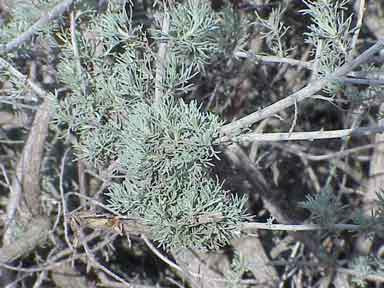
*California
sagebrush, coastal sagebrush (Artemisia
californica, Asteraceae) California sagebrush
is an aromatic evergreen shrub that grows
15 to 25 dm. (5 to 8 feet) tall. It is somewhat
drought deciduous. It has grayish green 1-
to 2-parted leaves divided into narrowly linear
lobes. The margins of the leaves curl under.
Its creamy/greenish pistillate and disk florets
are found in heads smaller than 5 mm. (less
than 1/4 inch) in diameter. They occur in
long racemose panicles at branch tips. The
blooms are visible from August through February.
California sagebrush is found primarily in
coastal scrub, chaparral in Poly Canyon.
Artemis
was the Greek goddess of the hunt and noted
herbalist, Queen of Anatolia (Diana in
Roman mythology). Californica means "of
California."
Chumash
used the wood of romerillo to make various
tools. They also used it in construction, medicine,
religious rites, as fire kindling, windbreaks,
and barricades. They smoked its leaves and used
them as incense and a fumigant.
|
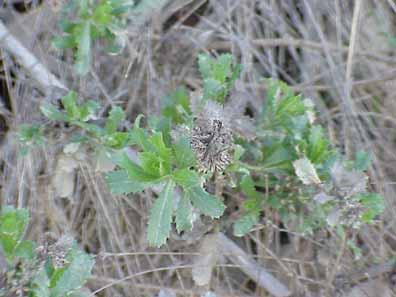
*Chaparral
broom, coyote bush, coyote brush (Baccharis
pilularis, Asteraceae) This is a less
than 3-m. (12-foot) evergreen dioecious dark
green shrub. It has 8-55-mm. (1/2-to 11/2-
inch) long ovate or obovate resinous leaves
usually with five to nine short teeth. Female
plants have a profusion of off-white flowers,
and male plants bear smaller cream-colored
flowers. Blooming is from August to November.
Coyote bush is found in coastal scrub, possibly
on serpentinite. It is often successional
after disturbance.
Coyote
bush was named after the god Bacchus. Pilularis
means "fruit globular."
Chumash
treated poison oak rash with a decoction of
the leaves of rama china (curly branch,
in Spanish). Dwarf races of Baccharis pilularis
are currently used as ornamental ground cover
|
|
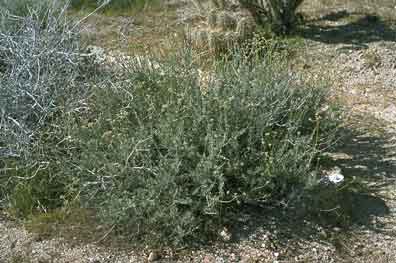
*California
buckwheat (Eriogonum fasciculatum,
Polygonaceae) California buckwheat is a 10-
to 200-cm. (4-inch to 7-foot) evergreen shrub.
It has 6-18 mm. (1/4- to 1/2-inch) long linear
fascicled leaves that are green and glabrous
above and white-woolly beneath. The leaf margins
turn under. The tiny pinkish flowers bloom from
March through October and are much visited by
bees. California buckwheat occurs in coastal
scrub, in canyons and on dry slopes.
Eriogonum
means "woolly knees" or "woolly joints." Fasciculatum
refers to the arrangement of the leaves in groups
called fascicles.
Early
Californians believed that drinking or bathing
in a tea made from poleo leaves was used
to relieve rheumatism and irregular menstruation.
The tea was also drunk to soothe stomach troubles.
In combination with sage, California buckwheat
was used to suppress menstruation. Poleo
is a Spanish word for mints.
|
|

California
broom, deerweed (Lotus scoparius,
Fabaceae) This is a 1/2- to 2-m. (2- to 3-foot)
drought deciduous subshrub. It has multiple
green (photosynthetic) stems bunched from ground
level. Leaves are pinnately compound. The three
to six elliptic leaflets are 6 to15 mm. (1/4
to 1/2 inch) long. Its tiny yellow-reddish pea-like
flowers are clustered in the leaf axils, especially
near stem tips. They bloom from March through
the summer. Pods have a curved beak and two
seeds. Deerweed occurs in coastal scrub and
chaparral communities. Deerweed is host to nitrogen-fixing
bacteria. These bacteria are able to take nitrogen
from the atmosphere and change it into a form
that makes it available as a nutrient to the
deerweed. Most other plants must absorb nutrients
from the soil.
Lotus
was the Greek name for a fruit whose ingestion
caused on to forget one's home. Scoparius
means "broom-like."
Escoba
de horno (oven broom, in Spanish) reflects
one of its uses. It also provided a black dye
and sweathouse thatching.
|

*Sticky
monkeyflower, bush monkeyflower (Mimulus
aurantiacus, Scrophulariaceae) This is
a 10- to 150-cm. (2- to 4-foot) tall evergreen
subshrub. It has 20- to 80-mm. (2-inch) glandular,
glutinous (sticky) leaves with edges that
are rolled under. The showy orange-yellow
to apricot-colored tubular flowers bloom from
March through July. The fruit is a loculicidal
capsule. Sticky monkeyflower occurs in coastal
scrub on open, rocky, dry hillsides and cliffs,
on canyon slopes, in disturbed areas, and
in chaparral borders.
Mimulus
comes from the Latin mimus, a comic actor,
because of the markings on the flowers. Aurantiacus
means "golden."
|
|
*Black sage (Salvia mellifera,
Lamiaceae)
click here
for description
|
|
*Western poison oak (Toxicodendron diversilobum,
Anacardiaceae)
click here
for description
|
Associated
species include:
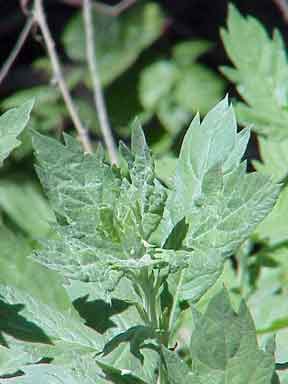
*Mugwort
(Artemisia douglasiana, Asteraceae)
This is a 5- to 25-dm. (11/2- to 8-foot) grayish
green woody based perennial herb. It has 1-
to 11-cm. (1/3- to 41/2-inch) leaves. The
uppermost leaves are usually entire, while
the lower ones are toothed or lobed. They
are tomentose (heavily so beneath). Its flowers
are borne in greenish heads that occur in
dense, leafy panicles from June through October.
Mugwort is found in moist open to shady places,
often in drainages.
Artemis
was the Greek goddess of the hunt and noted
herbalist, Queen of Anatolia (she was Diana
of Roman mythology). David Douglas was a 19th
century Scotsman sent by the (Royal) Horticultural
Society to collect plants in North America.
The
name estafiate may have been condensed
from de esta fíate, meaning "you can
trust this one". Another common name for mugwort
was yerba ceniza or ash plant, referring
to its color. Early Californians used mugwort
medicinally in a variety of ways. Its "wool"
was harvested by rubbing the dry plant between
ones palms and used to stop bleeding. Its leaves
were applied as plasters to soothe sore muscles.
To induce sweating, a sick person was extended
on a thick layer of mugwort leaves placed on
hot coals. The leaves were made into a poultice
for headaches or toothaches and boiled into
tea for asthma or headaches. A poultice of mugwort
is said to relieve inflammation and itching
from poison oak and nettles.
|
|
image
unavailable
California
fuchsia, Zauschneria (Epilobium canum,
Onagraceae) This is a 4- to 20-inch woody based
herbaceous perennial. It has grayish ovate,
opposite leaves are 1/2 to 3 inches long. Vivid
red-orange tubular flowers open from August
through October and are pollinated by hummingbirds.
The fruit is a capsule. California fuchsia is
found on dry slopes and ridges.
Epilobium
means "upon a capsule," referring to the simultaneous
flowering and fruiting. Canum means "ash-colored,"
as the leaf is so colored.
It
is called balsamillo or balsamea in Spanish.
The Chumash name s'akht'utun 'iyukhnuts
means "hummingbird sucks it." Chumash sprinkled
dried powdered leaves into cuts and sores to
heal them. They made a decoction of the leaves
to wash sprained limbs. It is used now as an
ornamental.
|
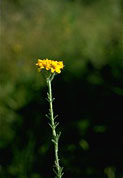
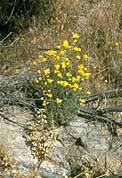
Golden-yarrow
(Eriophyllum confertiflorum, Asteraceae)
Golden-yarrow is a 2- to 7-dm. (8-inch to
21/4-foot) grayish woody based perennial herb.
It has lobed 21/2-cm.(1-inch) bright green
leaves that are white tomentose beneath. The
leaf margins are rolled under. The inflorescence
is a head of small, brilliant yellow flowers
blooming from April through August. Golden-yarrow
is found in many dry habitats.
Eriophyllum
means "woolly-leafed" in Greek. Confertiflorum
means "crowded flowers."
|
|
*Climbing bedstraw (Galium porrigens,
Rubiaceae)
click
here for description
|
|
image
unavailable
California
everlasting, cudweed (Gnaphalium californicum,
Asteraceae) California everlasting is a 20-
to 85-cm. (11/2- to 3-foot) tall biennial herb.
It has 2- to 15-cm. (11/2- to 4-inch) oblong
green, glandular, strongly-scented leaves. Its
white inflorescence is a corymb of flower heads
that bloom from January through July. California
everlasting is found on dry, open, or wooded
hills.
Gnaphalium
is Greek for "lock of wool."Californicum
means "of California."
|
|
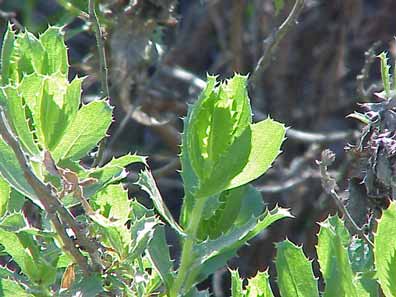
Saw-toothed
goldenbush (Hazardia squarrosa, Asteraceae)
This is a 3- to 23-dm. (1- to 71/2-foot) tall
resinous shrub. It has 11/2- to 5-cm. (1/2-
to 2-inch) oblong leathery, sharply serrate,
clasping leaves. The yellow-red florets occur
in discoid heads and bloom from August to November.
It occurs in shrubland habitats.
Barclay
Hazard was a 19th century California botanist.
Squarrosa means "scaly" or "rough" and
describes the involucres of the flower heads.
|
|
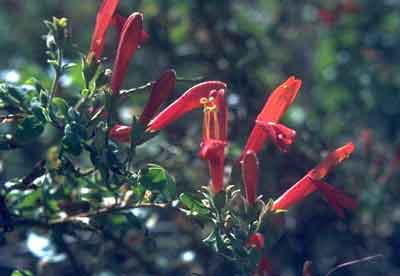
Brother Alfred Brousseau
Climbing
penstemon (Keckiella cordifolia,
Scrophulariaceae) Climbing penstemon is a less
than 30-dm. (10-foot) tall climbing or arching
perennial woody shrub. It has opposite dark
green ovate to cordate leaves. These have 20-
to 65-mm. (1- to 2-inch) blades with 3- to 11-toothed
margins. The vivid red or red-orange, 31- to
43-mm. (11/2-inch) tubular flowers bloom from
midspring to summer. It also occurs in chaparral
and woodland habitats.
David
Daniels Keck was a 20th century American botanist.
Cordifolia means "heart-shaped leaf"
in Latin.
Chumash
made tea of the leaves of moronel and
drank it for colds or used it to wash out sores
and wounds. Fresh leaves were used as a poultice.
|
|
image
unavailable
Giant
wild-rye (Leymus condensatus, Poaceae)
This is an 11- to 30-dm. (4- to 9-foot) perennial,
clumping grass that spreads by short rhizomes
(or has none). It has very strong stems. The
leaves are flat or rolled, and ribbed above.
Its 17- to 44-cm. (7- to 17-inch) inflorescence
is panicle-like, with sessile or stalked spikelets
of two to seven florets. Each floret has a single
awn measuring less than 4 mm. (1/6 inch). It
is found on dry slopes and in open woodlands.
Leymus
is an anagram of Elymus, the ancient
Greek name for millet, in which genus this grass
was previously included. Condensatus
means "condensed, crowded."
|
|
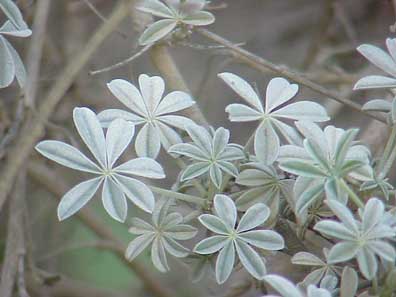
Bush
lupine (Lupinus albifrons, Fabaceae)
This is a 5- to 50-dm. (2- to 16-foot) summer-deciduous
shrub with hairy leaves. Each leaf is divided
into six to ten 10- to 30-mm. (1/3- to 11/4-inch)
leaflets. It has 8- to 30-cm. (11/2- to 11-inch)
racemes of violet to lavender 9- to 14-mm. (1/3-
to 1/2-inch) flowers. The flower's banner bears
a yellow-white patch that turns purple after
pollination. It blooms March through June. The
tissues of this plant contain alkaloids which
are toxic. Bush lupine is found in open sandy
or rocky habitats.
The
name Lupinus is derived from the Latin
for "wolf" because in antiquity these plants
were believed to rob the soil of nutrients.
This is ironic given modern knowledge of nitrogen-fixing
root nodules present in this group. Albi
means "white" in Latin. Frons refers
to the leaves, "fronds."
|
|
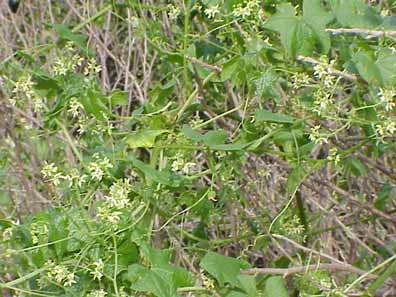
Wild
cucumber vine, California man-root (Marah
fabaceus, Cucurbitaceae) This is a 23/4-
to 61/2-m. (9- to 21-foot) deciduous vine. It
has broad, palmate (5- to 7-lobed) leaves. Its
spikes of yellowish-green, cream-colored, or
white 3- to 15-mm. (1/8- to 1/2-inch) rotate
monoecious flowers bloom from February through
April. The "cucumbers" are 4 to 5 cm. (2 to
3 inches) long, oblong, light green, prickly
poisonous gourds. The tuberous root can weigh
up to 100 lbs. Wild cucumber vine occurs in
shrubby and open areas and along streamsides.
Marah
refers to the bitter waters of Marah in the
Bible, a reflection of the bitter root of this
plant. Fabaceus means "bean-like," probably
because of the vine-like growth habit of the
plant.
|
|
*California peony (Paeonia californica,
Paeoniaceae)
click
here for description
|
|
*California coffeeberry (Rhamnus californica,
Rhamnaceae)
click
here for description
|
|
*Spiny redberry, Buckthorn (Rhamnus
crocea, Rhamnaceae)
click
here for description
|
|
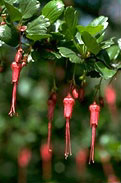
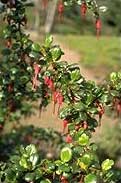
Fuchsia-flowered
gooseberry (Ribes speciosum, Grossulariaceae)
This is a 1- to 2-m. (3- to 6-foot) tall evergreen
spiny shrub. It has 3-lobed shiny dark green
leaves, the blades of which measure 1 to 31/2
cm. (1/3-inch). The showy hanging, magenta-red,
tubular flowers are 4-merous. The sepals and
petals measure from 4 to 5 mm. (1/6 inch). The
flowers bloom January through May. They are
hummingbird-pollinated. The fruit is a 10- to
12-mm. (1/4-inch) prickly, glandular berry.
Fuchsia-flowered gooseberry occurs in coastal
scrub and chaparral habitats.
Ribes
comes from the Syrian or Kurdish Ribas,
derived from Old Persian. Speciosum is
Latin for "showy" or "good-looking."
Barburi
is Chumash for "gooseberry of the deer." Chumash
did not eat the fruit from this plant.
|

Walter Knight
*Hummingbird
sage, pitcher sage (Salvia spathacea,
Lamiaceae) This is a 30- to 90-cm. (1- to
3-foot) tall perennial herb. It has 8- to
20-cm. (3- to 8-inch) opposite coarse oblong
leaves. Its brilliant magenta-red flowers
bloom in a 6-cm. (21/2-inch) wide spike of
several whorls from March through May. Brown
nutlets measure 31/2 to 61/2 cm. (1/6 to 1/3
inch). Flowers are hummingbird-pollinated.
Hummingbird sage is found in coastal scrub,
chaparral, and coastal live oak woodland habitats
on open or shady slopes.
Salvia
comes from the Latin salveo meaning "to
save" and refers to the medicinal uses of many
Salvias. Spathacea means "with a spathe."
Borraja
silvestre (wild borage) or diosa/diosita
(goddess or dear little goddess) are the local
Spanish names for this plant. Early Californians
made a decoction of its leaves as tea or for
a bath to cure pulmonary ailments and rheumatism.
|
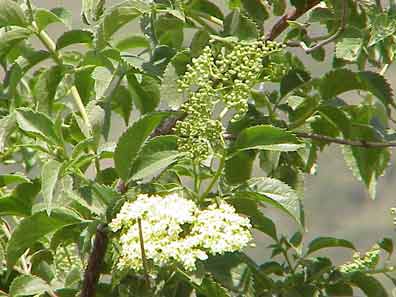
*Blue
elderberry (Sambucus mexicana,
Caprifoliaceae) This is a summer-deciduous
shrub or tree growing 2 to 8 m. (6 to 26 feet)
tall. It has compound leaves (3- to 9-finely
serrate, ovate to oblong leaflets measuring
3 to 20 cm. (1/2 to 21/2 inches)). Flat-topped,
umbel-like, compound cymes measure 4 to 33
cm. (11/2 to 13 inches) in diameter. They
bear fragrant, rotate, whitish 5-merous flowers
that bloom from March through September. Fruit
is a dark blue, berry-like drupe covered with
a waxy powder. Blue elderberry is found along
streambanks and in open woodlands.
Sambucus
comes from the Greek sambuke, a musical
instrument made from elder or alder wood. Mexicana
means "of Mexico."
Saúco,
the Spanish name for elder, was wood that was
cherished by early Californians. Those people
fashioned elder into tools, musical instruments,
and fire sticks. Its bark was woven into bags
for the collection of acorns and islay. Medicinally,
its flowers and leaves were made into tea to
treat colds and fever. Hollow elder stems became
syringes and were used in the letting of blood.
A poultice of buds on the head was used to treat
sunstroke. Flowers were burned as incense and
to induce sweating. The ashes of young branches
were used to sterilize wounds. The roots were
considered to be a strong laxative. Elder was
believed to provide protection from rattlesnakes
and magic for love.
|
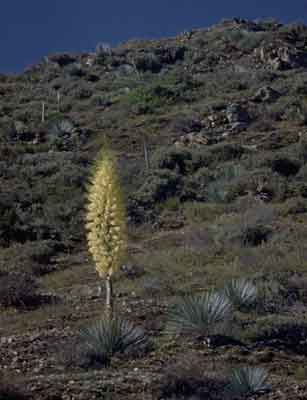
Charles Webber
*Yucca,
chaparral yucca, Our Lord's candle, Quixote
plant (Yucca whipplei, Liliaceae)
Yucca is a stemless subshrub with basal rosettes
of spinescent 40- to 100-cm. (1- to 3-foot)
long gray-green sword-like leaves. Its single
flower stalk is tipped with a purple-tinged
panicle of fragrant hanging cream-colored
flowers (sometimes tipped in purple). The
inflorescence measures from 2 to 40 dm. (8
inches to 13 feet. Yuccas bloom from April
through May. Pollination is done at night
by yucca moths, Tegeticula maculata,
who lay their eggs in the flowers' ovaries.
The moths have mouthparts that seem perfectly
adapted for carrying pollen from the stamen
to the stigma. The fruit is an oblong capsule.
Each plant dies after fruiting. Yuccas are
common on open coastal scrub and chaparral
hillsides. On dry, open serpentinitic slopes
and ridgetops, the dominant community may
be "yucca scrub."
Yuca
was a Haitian name for manihot, sweet cassava,
or tapioca. A.W. Whipple (1816-1863) was a topographical
engineer for the Pacific Railroad Survey in
1853. From a distance, a stand of yuccas in
bloom resembles candles, hence one of its common
names.
Several
names were used for yucca (as well as for Agave):
maguey, mescal, quiote,
and totemado. Early Californians used
its fibers for fishing lines and nets, belts,
threads for sewing canoe planks together, headbands,
and sandals. They also used it to pierce ears
and for tattooing, as well as for tinder.
|
|